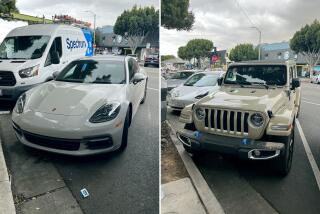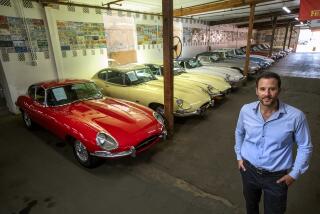For the Dimwitted, Fake Blue Headlights
- Share via
The desire to project upper-class status remains an undeniably important factor in how people choose what vehicles to drive, particularly in Southern California.
It goes back to the early days of the industry, when General Motors Chairman Alfred Sloan created a different car division to serve every economic class of buyer. The social pressure that people still feel manifests itself in some strange ways, leading to such things as fake car-phone antennas.
In a bizarre recent development, there are now fake blue headlight lenses showing up on the market that are supposed to create the illusion that a car is equipped with pricey high-intensity discharge lights known as xenon lamps.
These fakes are a sad commentary on social aspiration in our society, since they are both unsafe and illegal, bearing no resemblance to genuine xenon lamps.
The trend began about two years ago when luxury car makers, including BMW, Lincoln Mercury and Mercedes-Benz, came out with the distinctive headlamps that produce bluish light.
The National Highway Traffic Safety Administration has lengthy regulations, running about 50 pages, on all kinds of vehicle lights. These rules strictly regulate the amount of light that headlamps can disperse above a horizontal line in front of the car, but they impose no limit on the amount of light that falls on the road.
The xenon lamps are able to tightly focus more candlepower, a measurement of light, on the road without dispersing it into the eyes of oncoming drivers, said Steve Kratzke, director of NHTSA’s office of crash-avoidance standards.
“We feel there is a great safety benefit,” said Jim Kosh, a Mercedes spokesman.
But at what a price! When Mercedes introduced the xenon lamps as an option on its 1996 Mercedes-Benz S-Class luxury sedans, they were priced at $1,000. They now come in an option package priced at $1,200 that also includes rain-sensing automatic windshield wipers and headlight washers.
Can you imagine having a rock blast through one of these gems?
Kosh says, however, that the lamps have a much longer life than typical halogen automobile lights, although they will eventually need replacement.
The xenon lamps are not typical incandescents with an internal filament, as used on most vehicles. Rather, they operate like fluorescent lights with an electrical arc passing through a gas, in this case xenon. To the driver, the light appears white on the road ahead. But to oncoming drivers, it has a bluish tint.
*
The lamps are indeed striking and have become quickly synonymous with luxury vehicles. That, in turn, has created a market for those hordes of status seekers who can’t afford a BMW, Lincoln or Mercedes but want nonetheless to impress anonymous oncomers.
As a result of such demand, suppliers are producing low-cost bulbs that have a blue tint put in the glass. At the Cerritos Mall, one store was offering such bulbs for $60 a pair.
These bulbs generally do not meet federal guidelines and are illegal, although for safety reasons and not because of their bluish tint. Federal regulations do not outlaw tinted lenses.
The tinting, however, causes two problems: It disperses more light than ordinary halogens do above the road surface and into the eyes of oncoming drivers, and it puts less light on the road.
“It’s really the worst of both worlds,” Kratzke said.
NHTSA has received consumer complaints about the blue-tinted lights, and agency regulators have been attempting to track down the suppliers. All bulbs should carry a Department of Transportation certification with the identity of the manufacturer. The blue-tinted bulbs lack these imprints.
*
Ralph Vartabedian cannot answer mail personally but will attempt to respond in this column to automotive questions of general interest. Write to Your Wheels, Business Section, Los Angeles Times, Los Angeles, CA 90053. Via e-mail: ralph.vartabedian@latimes.com.







